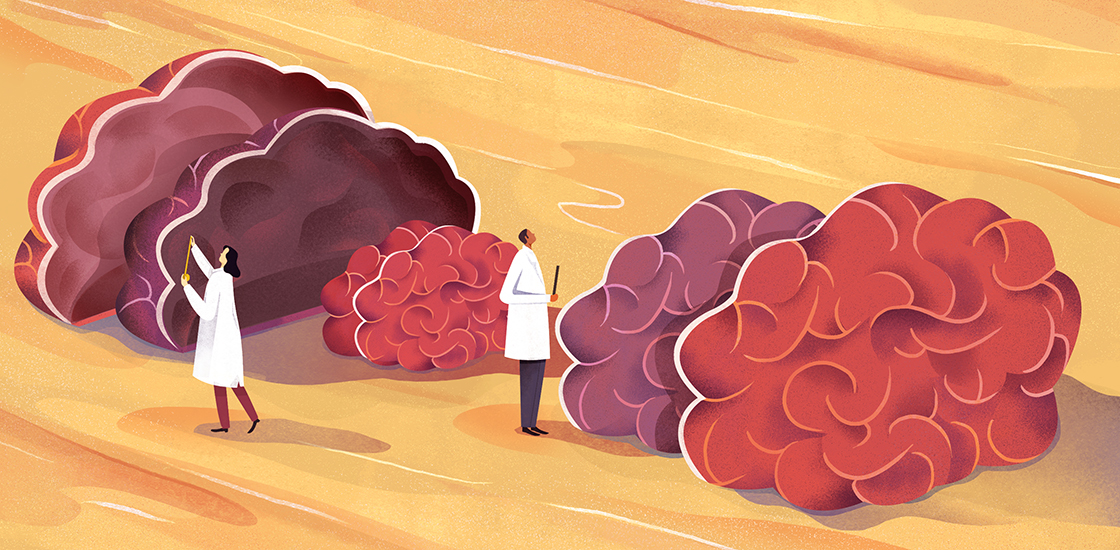Early brain enlargement augurs distinct form of autism
A minority of boys with autism have brains that are unusually large relative to their bodies — a trait tied to regression and intellectual disability.

In his 1943 paper first describing autism, Leo Kanner noted that 5 of 11 children with the condition “had relatively large heads1.” Since then, dozens of research studies have documented similar observations.
It’s clear that early brain enlargement is an oft-cited feature of autism. What’s less clear is how many children have it, and what it means.
My colleagues and I set out to explore whether early brain enlargement tracks with other features, such as intelligence. We did this because we believe that identifying neural characteristics that correlate with certain traits may point to subtypes of autism. We call these characteristics ‘neurophenotypes’ (not to be confused with endophenotypes, which reflect a genetic underpinning or heritable trait).
One of the first neurophenotypes we explored was brain size, using magnetic resonance imaging (MRI). We have found that a subset of boys with autism have brains that are unusually large relative to their bodies, and this trait is associated with behaviors such as regression and intellectual disability2.
Our efforts began in 2006, when we launched the Autism Phenome Project with the goal of identifying clinically meaningful biological subgroups of autism.
We enroll children soon after they receive an autism diagnosis between ages 2 and 3.5 years, at which point they undergo comprehensive behavioral assessments and MRI scans. We perform the scans at night while the children are asleep, which means we can scan children with all levels of functioning, including those at the severe end of the spectrum.
The children return for a scan once a year for the next two years. We perform a second behavioral assessment at the time of the second scan, when the children are about 5 years old.
Big differences:
We focused our initial analysis on the first MRI time point, when we scanned 129 boys with autism. (We had only about 25 girls with autism at the time.) At 2 to 3 years of age, these boys had brain volumes about 6 percent larger, on average, than those of age-matched typically developing boys. This finding is consistent with previous work.
A close look at the data revealed that a subgroup of boys with autism who have brain volumes outside the typical range are driving this mismatch. We found that 15 percent of boys with autism have what we call ‘disproportionate megalencephaly’ — brain volumes that are unusually large relative to their height.
We were interested in evaluating whether there were any clinically meaningful associations with this atypical brain enlargement. Data from the first assessment at age 3 showed that boys with megalencephaly have higher rates of regression, in which children lose skills they previously had. Megalencephaly is also associated with exposure to certain maternal antibodies in the womb.
We have since followed these children into early childhood and discovered that boys with autism and megalencephaly have a poorer prognosis than other children with autism. By age 5, boys with megalencephaly have made fewer cognitive gains than those whose brains are of typical size. They are also more likely to have intelligence quotients in the range of intellectual disability.
MRI scans at 4 and 5 years of age indicate that this brain enlargement persists. We have seen no signs of ‘normalization’ of brain size in early childhood3.
Growing up:
We are following children enrolled in the Autism Phenome Project into middle childhood: 9 to 11 years old. We are examining whether these children still show megalencephaly, and whether the cognitive issues we observed at age 5 persist as well.
The prevailing theory is that early brain overgrowth in children with autism normalizes during adolescence and adulthood. But this theory is based on comparing scans from a group of toddlers with those from a different group of adolescents, rather than tracking the same individuals over time. It is difficult to perform brain imaging on older individuals with severe autism features, so these studies may lack people with megalencephaly.
Girls are also underrepresented in brain imaging studies. We have been working hard to recruit girls for the Autism Phenome Project, and we now have close to 60 girls with autism. We see that at 2 to 3 years of age, only 3 percent of these girls have disproportionate megalencephaly. This finding suggests girls with autism have different neurophenotypes than boys with the condition.
There are likely many other neurophenotypes to explore — for example, patterns of neural connections or growth trajectories for specific brain regions. But to identify and fully understand the clinical significance of these neurophenotypes, we will need sample sizes in the hundreds rather than dozens, and longitudinal studies that start as close as possible to diagnosis, if not before, and that span all life stages. These studies will also need to include people from both sexes and all levels of functioning.
We still have a lot of work to do, but we think that identifying clinically meaningful neurophenotypes may lead to more targeted interventions, as well as a better understanding of the neural underpinnings of autism.
Christine Wu Nordahl is assistant professor of psychiatry at the University of California, Davis, MIND Institute.
References:
Recommended reading

Too much or too little brain synchrony may underlie autism subtypes

Developmental delay patterns differ with diagnosis; and more

Split gene therapy delivers promise in mice modeling Dravet syndrome
Explore more from The Transmitter

During decision-making, brain shows multiple distinct subtypes of activity

Basic pain research ‘is not working’: Q&A with Steven Prescott and Stéphanie Ratté
